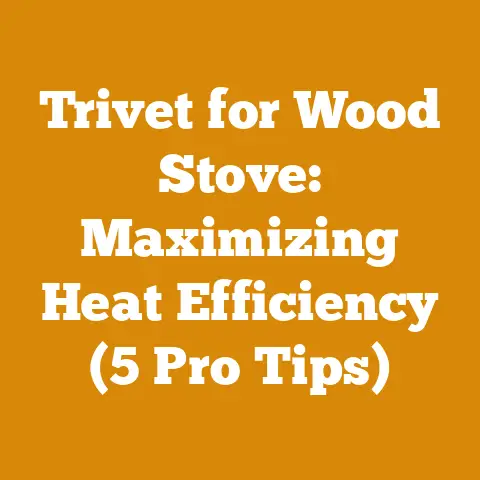Wood Stove Pellets Home Depot (5 Expert Tips for Quality Fuel)
Introduction: The Allure of Wood Stove Pellets – A Simple Change for Home Heating
As someone deeply entrenched in the world of wood processing, logging tools, and firewood preparation, I’ve seen many shifts in how people approach home heating. One of the most significant changes in recent years has been the rise of wood stove pellets. For those seeking a convenient, efficient, and relatively clean burning fuel source, wood pellets have become an increasingly popular option.
But here’s the thing: not all wood pellets are created equal. Just like with firewood, the quality of the pellets you burn can drastically affect the performance of your wood stove, the amount of heat you get, and even the longevity of your appliance. That’s why simply grabbing the cheapest bag off the shelf at Home Depot might not be the best strategy.
In this article, I want to share my expert tips for selecting high-quality wood stove pellets, particularly when shopping at Home Depot. I’ll delve into what to look for, what to avoid, and how to ensure you’re getting the best fuel for your wood-burning needs. Think of it as a guide to navigating the often-overwhelming world of wood pellets, so you can make informed decisions and keep your home warm and cozy all winter long.
Why Choose Wood Stove Pellets?
Before diving into the specifics of selecting pellets at Home Depot, let’s quickly recap why wood pellets have become such a popular choice for home heating.
Convenience: Pellets are easy to store, handle, and load into your stove. They come in manageable bags and can be neatly stacked, unlike bulky cords of firewood.
Efficiency: Wood pellet stoves are designed for efficient combustion, meaning they extract more heat from the fuel compared to traditional wood stoves.
Clean Burning: When burned correctly, wood pellets produce significantly less smoke and emissions than firewood, contributing to cleaner air quality.
Consistent Heat Output: Pellet stoves offer precise control over heat output, allowing you to maintain a consistent temperature in your home.
Renewable Resource: Wood pellets are made from renewable resources like sawdust and wood waste, making them a sustainable heating option.
Now, let’s get to the heart of the matter: how to ensure you’re getting the best possible wood stove pellets when shopping at Home Depot.
5 Expert Tips for Selecting Quality Wood Stove Pellets at Home Depot
1. Understanding Pellet Grades: The Key to Unlocking Optimal Performance
The first and arguably most crucial step in selecting wood stove pellets is understanding pellet grades. These grades are determined by independent testing agencies and reflect the quality and performance characteristics of the pellets. Primarily, you’ll encounter two main grades: Premium and Standard.
Premium Pellets: These are the top-tier pellets, manufactured to the highest standards. They typically have a lower ash content (less than 1%) and produce more heat per pound than standard pellets. Premium pellets are ideal for homeowners seeking maximum efficiency and minimal maintenance.
Standard Pellets: While still a viable option, standard pellets have a slightly higher ash content (between 1% and 3%) and may produce slightly less heat. They are often more affordable than premium pellets but may require more frequent cleaning of your stove.
Why Ash Content Matters: Ash is the non-combustible residue left behind after burning wood. High ash content can lead to clinker formation, reduced heat output, and increased maintenance requirements. I’ve personally experienced the frustration of burning low-quality pellets with high ash content – having to clean the stove every other day is a real pain!
Beyond Premium and Standard: You might also encounter other terms like “Super Premium” or “Economy” pellets. These are often marketing terms and may not adhere to strict industry standards. Always look for independent certification from a reputable testing agency like the Pellet Fuels Institute (PFI) to ensure the pellets meet the advertised specifications.
Data-Backed Insights: According to the Pellet Fuels Institute, premium pellets typically have a heating value of around 8,500 BTU per pound, while standard pellets may have a slightly lower value. This difference in heating value can translate to significant cost savings over the long run, as you’ll need to burn less premium pellets to achieve the same level of heat.
My Personalized Storytelling: Years ago, I made the mistake of buying a bulk shipment of “economy” pellets from a local supplier. They were significantly cheaper than the premium pellets I usually bought, but I quickly learned my lesson. The stove required cleaning almost daily, and the heat output was noticeably lower. In the end, I spent more time and effort maintaining the stove, and I probably didn’t save much money overall.
Actionable Advice: When shopping at Home Depot, carefully examine the pellet bags for information on pellet grade and ash content. Look for the PFI certification mark to ensure the pellets meet industry standards. Don’t be afraid to ask a store associate for more information or to see the testing results for a particular brand of pellets.
2. Moisture Content: The Silent Killer of Pellet Performance
Moisture content is another critical factor that significantly impacts the performance of wood stove pellets. Just like with firewood, wet pellets don’t burn efficiently and produce less heat.
The Ideal Moisture Content: High-quality wood pellets should have a moisture content of less than 8%. This low moisture content allows for efficient combustion and maximizes heat output.
How Moisture Affects Burning: When pellets have a high moisture content, a significant portion of the energy produced during combustion is used to evaporate the water instead of generating heat. This results in lower overall efficiency and can even lead to incomplete combustion, producing more smoke and emissions.
Identifying Moisture Problems: It can be challenging to assess the moisture content of pellets simply by looking at the bag. However, there are a few telltale signs that can indicate potential moisture problems:
- Clumping: If the pellets are clumped together or feel damp to the touch, they may have absorbed moisture.
- Musty Odor: A musty or moldy odor can indicate that the pellets have been exposed to moisture and may be deteriorating.
- Discoloration: Discoloration or staining on the pellet bag can also be a sign of moisture damage.
Data-Backed Insights: Studies have shown that for every 1% increase in moisture content above the ideal level, the heating value of wood pellets can decrease by approximately 2%. This means that pellets with a moisture content of 15% could have a heating value that is 14% lower than pellets with a moisture content of 8%.
My Personalized Storytelling: I once purchased several bags of pellets from Home Depot that had been stored improperly in an outdoor storage area. The bags were slightly damp, and the pellets had a faint musty odor. I decided to try burning them anyway, but the results were disappointing. The stove produced less heat, and the glass door became coated with soot much faster than usual. I ended up having to discard the remaining pellets, as they were simply not worth burning.
Actionable Advice: When buying pellets at Home Depot, carefully inspect the bags for any signs of moisture damage. Avoid bags that are torn, punctured, or appear to have been exposed to water. If possible, choose pellets that have been stored indoors or in a covered area. If you’re unsure about the moisture content of a particular bag of pellets, ask a store associate for assistance or choose a different brand.
3. Pellet Density and Size: The Foundation of Consistent Feeding
Pellet density and size are often overlooked but play a crucial role in the performance and reliability of your wood pellet stove. Consistent pellet size and density ensure smooth and even feeding into the combustion chamber, which translates to stable heat output and reduced maintenance.
Ideal Pellet Density: High-quality wood pellets should be dense and compact, with a uniform size and shape. This density allows for consistent feeding and efficient combustion.
The Impact of Inconsistent Size and Density: If the pellets are too small, they may burn too quickly or even fall through the grate into the ash pan. If they are too large or uneven, they may clog the auger or disrupt the feeding mechanism. Low-density pellets tend to burn less efficiently and produce more ash.
Assessing Pellet Density and Size: While you can’t measure the density of pellets without specialized equipment, you can visually assess their size and uniformity. Look for pellets that are consistent in length and diameter, with a smooth and even surface. Avoid pellets that are broken, cracked, or have excessive amounts of dust or fines.
Data-Backed Insights: Studies have shown that pellet density is directly correlated with heating value. Denser pellets contain more wood fiber per unit volume, which translates to more energy released during combustion.
My Personalized Storytelling: I once experimented with making my own wood pellets using a small-scale pellet mill. While the process was interesting, I quickly realized that achieving consistent pellet density and size was more challenging than I anticipated. The homemade pellets tended to crumble easily and didn’t feed as smoothly into my stove as commercially produced pellets. This experience gave me a greater appreciation for the precision and quality control that goes into manufacturing high-quality wood pellets.
Actionable Advice: When selecting pellets at Home Depot, visually inspect the pellets through the clear plastic windows often found on the bags. Look for pellets that are uniform in size and shape, with minimal dust or fines. If possible, gently shake the bag to see if the pellets crumble easily. Avoid bags that contain a lot of broken or damaged pellets.
4. Source and Manufacturing Process: The Story Behind the Fuel
Understanding the source and manufacturing process of wood pellets can provide valuable insights into their quality and sustainability.
Sustainable Sourcing: Look for pellets that are made from sustainably sourced wood waste, such as sawdust, wood shavings, and mill residues. This ensures that the pellets are a renewable resource and that the manufacturing process doesn’t contribute to deforestation.
Manufacturing Practices: The manufacturing process can also affect the quality of the pellets. High-quality pellets are typically manufactured using state-of-the-art equipment and undergo rigorous quality control measures. These processes ensure consistent pellet density, moisture content, and ash content.
Transparency and Traceability: Look for pellet manufacturers that are transparent about their sourcing and manufacturing practices. Some manufacturers even provide traceability information, allowing you to track the origin of the wood used to make the pellets.
Data-Backed Insights: A study by the Biomass Energy Resource Center found that wood pellets made from sustainably sourced wood waste have a significantly lower carbon footprint than fossil fuels like oil and natural gas.
My Personalized Storytelling: I’ve had the opportunity to visit several wood pellet manufacturing plants and witness the production process firsthand. I was impressed by the level of automation and quality control involved. The plants use sophisticated equipment to dry, grind, and compress the wood waste into uniform pellets. They also conduct regular testing to ensure that the pellets meet strict quality standards.
Actionable Advice: When shopping at Home Depot, look for pellets that are made from sustainably sourced wood waste and that have been manufactured using environmentally responsible practices. Check the pellet bag or the manufacturer’s website for information on sourcing and manufacturing. Consider choosing pellets from manufacturers that are certified by organizations like the Sustainable Biomass Program (SBP).
5. Storage and Handling: Protecting Your Investment
Proper storage and handling are essential to maintain the quality of your wood stove pellets. Even the highest quality pellets can deteriorate if they are not stored correctly.
Ideal Storage Conditions: Wood pellets should be stored in a dry, well-ventilated area, away from moisture and direct sunlight. Moisture is the biggest enemy of wood pellets, as it can lead to clumping, mold growth, and reduced heating value.
Storage Options: There are several options for storing wood pellets, including:
- Original Bags: The original pellet bags are designed to protect the pellets from moisture, but they are not completely waterproof. It’s best to store the bags indoors or in a covered area.
- Plastic Bins: Plastic bins provide a more secure and waterproof storage option. Make sure the bins have tight-fitting lids to prevent moisture from entering.
- Pellet Silos: For homeowners who use a large volume of pellets, a pellet silo is a convenient and efficient storage solution. Pellet silos are typically made of metal or plastic and can hold several tons of pellets.
Handling Precautions: When handling wood pellets, avoid dropping or crushing the bags, as this can damage the pellets and create dust. Use a dolly or hand truck to move heavy bags of pellets to prevent back strain.
Data-Backed Insights: A study by the University of Maine found that wood pellets stored in a damp environment can absorb up to 15% of their weight in moisture within a few weeks. This increased moisture content can significantly reduce the heating value of the pellets and lead to stove problems.
My Personalized Storytelling: I once made the mistake of storing several bags of pellets in my garage, which was prone to dampness during the rainy season. Over time, the pellets absorbed moisture and became clumpy and moldy. When I tried to burn them, they produced very little heat and created a lot of smoke. I learned my lesson the hard way and now always store my pellets in a dry, well-ventilated area.
Actionable Advice: When you purchase pellets from Home Depot, transport them carefully to your home and store them in a dry, well-ventilated area. Avoid storing pellets in damp basements, garages, or sheds. If you live in a humid climate, consider using plastic bins with tight-fitting lids to protect the pellets from moisture.
Now that we’ve covered the essential tips for selecting quality wood stove pellets, let’s focus on how to apply these tips specifically when shopping at Home Depot.
1. Research Before You Go: Before heading to Home Depot, take some time to research the different brands of wood pellets they carry. Check online reviews, compare prices, and look for information on pellet grade, ash content, and sourcing.
2. Check the Pellet Labels Carefully: Once you’re at Home Depot, carefully examine the labels on the pellet bags. Look for information on pellet grade, ash content, moisture content, and heating value. Pay attention to any certifications, such as the PFI certification mark.
3. Inspect the Bags for Damage: Carefully inspect the pellet bags for any signs of damage, such as tears, punctures, or stains. Avoid bags that appear to have been exposed to moisture.
4. Ask for Assistance: Don’t hesitate to ask a Home Depot associate for assistance. They may be able to provide you with additional information about the pellets, such as testing results or sourcing information.
5. Consider Buying in Bulk: If you have the storage space, consider buying pellets in bulk. This can often save you money and ensure that you have a sufficient supply of fuel for the winter.
6. Take Advantage of Sales and Promotions: Home Depot often runs sales and promotions on wood pellets, especially during the off-season. Keep an eye out for these deals to save money on your fuel costs.
7. Read Online Reviews: Check online reviews before buying. Look for common issues and experiences from other users.
8. Check the Manufacturing Date: If available, check the manufacturing date. Ideally, you want pellets that are relatively fresh, as older pellets may have absorbed moisture over time.
Real-World Example: I recently visited my local Home Depot to check out their wood pellet selection. I noticed that they carried several different brands, including some that I had never heard of before. I carefully examined the labels on the bags and compared the prices and specifications. I ended up choosing a brand that was PFI-certified and had a low ash content. I also made sure to inspect the bags for any signs of damage before making my purchase.
Beyond the Basics: Advanced Tips for Wood Pellet Enthusiasts
For those who want to take their wood pellet knowledge to the next level, here are some advanced tips to consider:
1. Experiment with Different Brands: Don’t be afraid to experiment with different brands of wood pellets to see which ones perform best in your stove. Keep track of your observations, such as heat output, ash production, and stove maintenance requirements.
2. Consider Blending Pellets: Some wood pellet enthusiasts like to blend different types of pellets to achieve a desired combination of heat output, burn time, and ash production.
3. Monitor Your Stove’s Performance: Regularly monitor your wood pellet stove’s performance to identify any potential problems. Pay attention to the flame pattern, heat output, and ash accumulation.
4. Perform Regular Maintenance: Regular maintenance is essential to keep your wood pellet stove running efficiently and safely. This includes cleaning the stove, inspecting the auger and blower, and replacing worn parts.
5. Stay Informed About Industry Developments: The wood pellet industry is constantly evolving, with new technologies and products being developed all the time. Stay informed about industry developments by reading trade publications, attending industry events, and following relevant online forums.
6. Use a Pellet Stove Thermostat: Using a thermostat designed for pellet stoves can help maintain a consistent temperature and improve fuel efficiency.
7. Invest in a Pellet Stove Vacuum: A specialized vacuum for pellet stoves makes cleaning the stove much easier and more efficient.
8. Understand Your Stove’s Settings: Familiarize yourself with your pellet stove’s settings to optimize its performance and efficiency.
Conclusion: Making Informed Choices for a Warm and Efficient Home
Selecting quality wood stove pellets at Home Depot doesn’t have to be a daunting task. By understanding pellet grades, moisture content, density, source, and storage requirements, you can make informed choices that will ensure a warm and efficient home all winter long.
Remember to always inspect the pellet bags carefully, look for certifications, and don’t hesitate to ask for assistance from Home Depot associates. With a little bit of knowledge and effort, you can find the perfect wood pellets to meet your needs and keep your wood stove running smoothly for years to come.
Key Takeaways:
- Understand pellet grades (Premium vs. Standard) and their impact on performance.
- Check for moisture content and avoid bags with signs of damage.
- Look for consistent pellet size and density for smooth feeding.
- Choose pellets from sustainable sources and responsible manufacturers.
- Store pellets properly to maintain their quality.
Next Steps:
- Research the different brands of wood pellets available at your local Home Depot.
- Visit Home Depot and inspect the pellet bags carefully.
- Experiment with different brands to find the best option for your stove.
- Monitor your stove’s performance and perform regular maintenance.
By following these tips, you can ensure that you’re getting the best possible value for your money and that your wood stove is operating at its peak efficiency. Happy heating!






